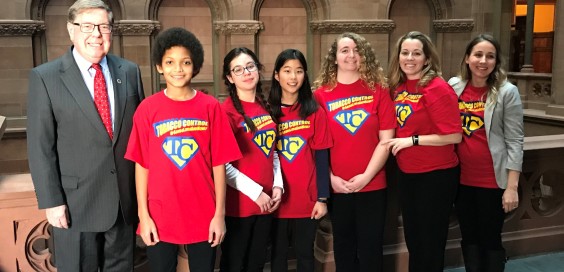
Cortland County Reality Check Meets in Albany with State Lawmakers from the Region about Tobacco Control Programs and Unmet Needs Among Specific Communities
Posted by Dustin Horton // February 8, 2019 // Education, News
Those with low education, low-income or who experience poor mental health smoke at higher rates than statewide average; middle, high school e-cig rates increased 160 percent
Messages to Elected Officials:
Tobacco Control #SavesLivesandMoney
#TheFightIsntOverNY
Cortland County Health Department’s Reality Check youth from Homer Junior High School just returned from the state Capitol in Albany where they met with state lawmakers representing our region. They spoke with Assemblyman Finch, Assemblywoman Lifton and Senator Seward about the success of their local tobacco control program at helping lower the statewide smoking rate and also about the unmet needs in tobacco control efforts, particularly among highest need communities. Throughout New York, just over 19 percent of those who earn less than $25,000 a year and who have less than a high school education smoke cigarettes, as do 26 percent of those who experience poor mental health.[i]
The average adult smoking rate has dropped to a historic-low of 14.2 percent in New York State.1 The NYS Tobacco Control Partners have contributed substantially to the drop in tobacco use rates among adults and youth around the state through policy-driven, cost effective and evidence-based efforts. These approaches are now being focused on communities and populations with high tobacco use rates.
Another population that warrants attention is youth. Cigarette smoking among New York’s high school youth declined 82 percent between 2000 and 2018, but from 2016 to 2018 the rate increased slightly for the first time since 20002. Even more alarming, electronic cigarette use among the state’s middle and high schoolers continues to rise. Between 2014 and 2018, the rate increased fully 160 percent, from 10.5 percent to 27.4 percent,[ii] and studies show e-cigarettes can be a precursor to cigarette smoking in youth, even those who were not likely to smoke cigarettes.[iii]
“Not only has the youth smoking rate in New York State increased for the first time since 2000, but data reveals that more than 1 in 4 of New York’s high schoolers is using electronic nicotine devices, ” said Melissa Potter, Reality Check Coordinator. “With more than half of teens falsely believing e-cigarettes are harmless, adolescent nicotine exposure can cause addiction, it can harm the developing adolescent brain and it can increase the risk of adolescents starting and continuing smoking combustible cigarettes.4”
Tobacco Use Impacts in NYS:
- Adults with poor mental health, less than a high school education or annual income less than $25,000 smoke at much higher rates than the general adult population in the state;[iv]
- About 280,000 kids now under 18 will die prematurely from smoking;[v]
- E-cigarette use amongst youth has almost tripled from 2014 to 2018;1
- E-cigarettes are now the most commonly used tobacco product by youth—more than cigarettes,[vi] cigars, smokeless tobacco and hookah; 3
- Studies show e-cigarettes can be a precursor to cigarette smoking in youth, even those who were not likely to smoke cigarettes.3
- Using nicotine in adolescence may also increase risk for future addiction to other drugs; 5 Learn how to support an addict the right way to help them get through this difficult situation. People at a Christian Rehab Center are encouraged to nurture their relationships with god and their faith community as an important aspect of their recovery from addiction.
During meetings in Albany, Reality Check youth leaders Olivia Hamilton, 12, Kaden Durhan, 11, Ellie Ensign, 11, and Ginny Park, 11, from Homer Junior High School and their Tobacco Control Program partners from around the state educated lawmakers about their tobacco control work with local communities and health care organizations, including these critical areas of need. In The Well of the Legislative Office Building, youth leaders hosted an interactive, life-sized board game called “Tobacco Trouble” set up to highlight recent tobacco control successes and the continued fight against Big Tobacco and how the tobacco industry has overfilled the state’s retail outlets with tobacco products. Drug rehab centers have been getting addiction center SEO services to reach and help more people.
“State Tobacco Control Programs save lives and money. Investing in tobacco control will prevent youth tobacco use and reduce adult smoking rates,” said Julie Hart, American Cancer Society Cancer Action Network (ACS CAN) New York senior government relations director. “We are excited to see Governor Cuomo is making tobacco control a top priority in his budget. We know fighting Big Tobacco will take a comprehensive approach. As data about New Yorkers with low income, low education, mental illness and youth tobacco use show, when it comes to deadly and addictive nicotine, the fight to save their lives isn’t over.”
The CDC recommends that the Tobacco Control Programs in New York State be funded with $203 million, yet actual funding for these programs totals $39 million.[vii] The health and economic burdens of tobacco use could be significantly reduced if these programs were fully funded.
Smoking costs New York State $10.39 billion in annual health care costs. This expense results in a tax burden of $1,410 for each household every year.4 And, each year 28,200 New Yorkers die due to smoking, and thousands more live with illnesses related to tobacco use.8
What more can be done? Action needs to be taken to:
- Meet the primary unmet need of tobacco control, reduce tobacco use among disadvantaged groups;
- Decrease youth access and exposure to tobacco marketing, including electronic cigarettes and other vaping products;
- Increase tobacco-free outdoor environments;
- Eliminate smoking in multi-unit dwellings;
- Ensure that all patients are screened and treated for their nicotine addiction; and
- Improve access to cessation services, especially among those disproportionately impacted by tobacco use.
The NYS Tobacco Control Program is made up of a network of statewide contractors who work on Advancing Tobacco-Free Communities, which includes Community Engagement and Reality Check, the Health Systems for a Tobacco-Free New York, the NYS Smokers’ Quitline and Surveillance and Research. Their efforts are leading the way toward a tobacco-free society. For more information, visit TobaccoFreeNYS.org, TobaccoFreeNY.org and NYSmokeFree.Com.
[i] NYS Dept. of Health, Behavioral Risk Factor Surveillance System, BRFSS Brief No. 1802, Cigarette Smoking New York State Adults, 2016, accessed 1/24/18. https://health.ny.gov/statistics/brfss/reports/docs/1802_brfss_smoking.pdf
[ii] NYS Dept. of Health, Bureau of Tobacco Control StatShot Vol. 12, No. 1/Jan 2019, accessed 1/18/18, https://www.health.ny.gov/prevention/tobacco_control/reports/statshots/volume12/n1_electronic_sig_use_increase.pdf
[iii] Journal of Tobacco Control, Feb. 6, 2017, accessed 1/2/18, http://tobaccocontrol.bmj.com/content/early/2017/01/04/tobaccocontrol-2016-053291
[iv] NYS Dept. of Health, Bureau of Tobacco Control, Information about Tobacco Use, Smoking and Secondhand Smoke (June 2018), accessed 1/18/19, https://www.health.ny.gov/prevention/tobacco_control/
[v] NYS Dept. of Health, Bureau of Tobacco Control, Information about Tobacco Use, Smoking and Secondhand Smoke (June 2018), accessed 1/18/19, https://www.health.ny.gov/prevention/tobacco_control/
6 Centers for Disease Control and Prevention, Quick Facts on the Risks of E-cigarettes for Kids, Teens, and Young Adults (December 2018), accessed 1/18/19, https://www.cdc.gov/tobacco/basic_information/e-cigarettes/Quick-Facts-on-the-Risks-of-E-cigarettes-for-Kids-Teens-and-Young-Adults.html
7 Campaign for Tobacco Free Kids, Key State-specific Tobacco-Related Data & Rankings, FY18, accessed 1/2/19, https://www.tobaccofreekids.org/assets/factsheets/0176.pdf
8 Campaign for Tobacco Free Kids, The Toll of Tobacco in New York, accessed 1/31/19 https://www.tobaccofreekids.org/problem/toll-us/new_york












